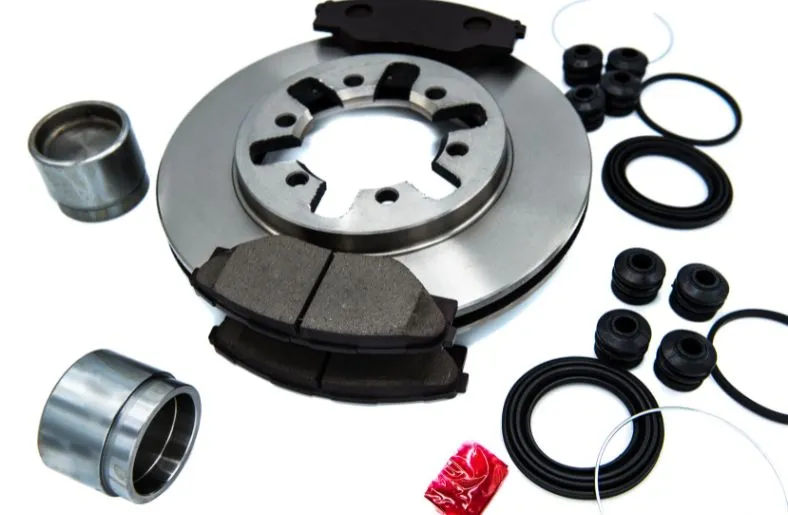Your vehicle’s braking system is undoubtedly one of the most critical safety components. To ensure it operates at its best, it’s essential to perform regular maintenance, including lubricating the brake caliper pistons. Properly lubricating these pistons can not only extend their lifespan but also improve brake performance and reduce the chances of issues like sticking or uneven wear.
In this comprehensive guide, we will walk you through the step-by-step process of how to lubricate brake caliper pistons. Whether you’re a seasoned mechanic or a DIY enthusiast, these instructions will help you maintain your brakes and keep your vehicle safe on the road.
Table of Contents
Brake Caliper Pistons
Before diving into the lubrication process, it’s crucial to understand the role of brake caliper pistons in your vehicle’s braking system. Brake calipers are responsible for squeezing the brake pads against the rotors, generating the friction needed to slow down or stop the vehicle. Pistons inside the calipers play a pivotal role in this process.
Brake caliper pistons are usually made of metal or composite materials and are situated inside the caliper housing. When you press the brake pedal, brake fluid is forced into the caliper, causing the pistons to move outward, pressing the brake pads against the rotors. Proper lubrication ensures these pistons move smoothly and return to their original position when you release the brake pedal.
How to Lubricate Brake Caliper Pistons: A Step-by-Step Guide
Necessary Tools and Materials
Before you start lubricating your brake caliper pistons, gather the necessary tools and materials. Here’s a list of what you’ll need:
- Jack and jack stands: To safely lift and secure your vehicle.
- Wheel removal tools: Such as a lug wrench.
- Brake cleaner: To clean the caliper and surrounding areas.
- Brake fluid: In case you need to top off your brake fluid reservoir.
- C-Clamp or brake caliper tool: To compress the caliper piston.
- Lubricant: High-temperature silicone-based brake caliper grease is recommended.
- Rubber gloves and safety glasses: For personal protection.
- Rags or paper towels: To clean and wipe off excess grease.
Preparing Your Vehicle
Before you can access the brake caliper pistons, you need to prepare your vehicle. Follow these steps:
- Park your vehicle on a level surface: Ensure it’s in gear or in “Park” and engage the parking brake.
- Loosen the lug nuts: Using the lug wrench, but do not remove them completely.
- Lift the vehicle: Use the jack to lift the vehicle off the ground, and secure it with jack stands for safety.
- Remove the wheel: Finish removing the loosened lug nuts and take off the wheel to access the brake caliper.
Cleaning the Caliper
Before lubricating the brake caliper pistons, it’s crucial to clean the caliper and surrounding area. This ensures that no dirt or debris gets inside the caliper when you disassemble it. Here’s how to do it:
- Spray brake cleaner: Use the brake cleaner to thoroughly clean the caliper, paying special attention to the area around the piston and the caliper slide pins.
- Let it dry: Allow the brake cleaner to evaporate completely before proceeding.
Removing the Caliper
Now that the caliper is clean, you can begin the process of removing it from the rotor. This step is essential for accessing the brake caliper pistons. Follow these steps:
- Locate the caliper bolts: They are usually located on the backside of the caliper. These bolts secure the caliper to the bracket.
- Use the appropriate tool: Depending on your vehicle, you may need a socket wrench or an Allen wrench to remove the caliper bolts.
- Carefully detach the caliper: Once the bolts are removed, gently slide the caliper off the rotor. Be cautious not to damage the brake line attached to the caliper.
Compressing the Caliper
With the caliper removed, you can now access the brake caliper pistons. Before lubricating them, you need to compress them slightly to create space for the new grease. Here’s how to do it:
- Position the C-Clamp or caliper tool: Place it over the caliper piston and the back of the caliper.
- Slowly tighten: Gradually tighten the C-Clamp or use the caliper tool to compress the piston. Keep an eye on the brake fluid reservoir as fluid may be displaced.
- Check the piston: Ensure it’s fully compressed and flush with the caliper housing.
Lubricating the Brake Caliper Pistons
Now comes the crucial part: lubricating the brake caliper pistons. Proper lubrication ensures smooth piston movement, preventing sticking or uneven wear. Follow these steps:
- Choose the right lubricant: Select a high-temperature silicone-based brake caliper grease. This type of grease is designed to withstand the heat generated during braking.
- Apply a thin layer of grease: Using a clean, lint-free cloth or a disposable brush, apply a thin layer of grease to the piston’s surface. Be sure not to overdo it; a little goes a long way.
- Rotate the piston: Gently turn the piston while applying the grease. This ensures an even distribution of lubricant.
- Lubricate the slide pins: While you’re at it, it’s a good idea to apply a thin layer of grease to the caliper slide pins as well. These pins play a crucial role in caliper movement.
Reassembling the Caliper
Now that you’ve successfully lubricated the brake caliper pistons, it’s time to reassemble the caliper and put everything back together. Follow these steps:
- Slide the caliper back onto the rotor: Carefully position the caliper over the rotor and align it with the caliper bracket.
- Reinsert the caliper bolts: Tighten the caliper bolts securely but do not over-tighten.
- Replace the wheel: Put the wheel back on and hand-tighten the lug nuts.
- Lower the vehicle: Remove the jack stands and carefully lower the vehicle back to the ground using the jack.
Related Guide: A Comprehensive Guide on How to Lubricate a Power Recliner (2023-2024)
Final Steps and Testing
To complete the process, follow these final steps:
- Tighten the lug nuts: Use a torque wrench to tighten the lug nuts to the manufacturer’s specifications.
- Check the brake fluid: Inspect the brake fluid reservoir and top it off if necessary. Be sure not to overfill.
- Pump the brake pedal: Before driving, pump the brake pedal a few times to reseat the caliper pistons. This ensures that your brakes are responsive when you hit the road.
Conclusion
Properly lubricating brake caliper pistons is a critical aspect of brake maintenance that can improve your vehicle’s safety and performance. With the step-by-step guide outlined above on how to lubricate brake caliper pistons, you can confidently tackle this task and keep your brakes in top-notch condition.
Regular brake caliper piston lubrication not only ensures smooth operation but also extends the life of your braking system, potentially saving you from costly repairs down the road. So, take the time to care for your brake calipers, and drive with peace of mind knowing your vehicle’s stopping power is at its best.

